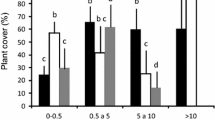Summary
In a Danish heathland invasion of oak shrub has taken place, the succession rate being approximately 300 m during the last 100 years. The colonisation has occurred in steps related to the delay time between seedling stage and fertility stage. Seedlings are often found in clusters originating from caches probably made by seed-eating rodents. Apodemus sylvaticus, A. flavicollis and Clethrionomys glareoles. These rodents reached autumn densities of 25–50 individuals per ha. Radioactive acorns were scatterhoarded by the rodents, which mainly deposited the acorns singly up to at least 34 m from the oak shrub (mean 15.3±8.2 m), and preferably under Empetrum nigrum mats in the walls of runways Seedlings originating from radioactive acorns were found next summer at distances of 4–37 m from the oak shrub. In early summer caches containing new seedlings had a mean size of 2.0±2.2 acorns, range 1–16; mean distance of seedlings to nearest crown projection was 24.0±23.6 m, range 1–137. Thus, rodent acorn dispersal can explain the observed succession rate of oaks into the heathland
Similar content being viewed by others
References
Abbott HG, Quinck TF (1970) Ecology of eastern white pine seed caches made by small forest mammals Ecology 51:271–278
Bang P, Dahlström P (1972) Dyrespor — Gad, Copenhagen
Barnett RJ (1977) The effect of burial on germination and survival of oak hickory nuts. Am Midl Nat 98:319–330
Böcher T (1943) Studies on the plant geography of the North-Atlantic heath formation. II. Danish dwarf shrub communities in relation to those of northern Europe. — D Kgl Danske Vid Selsk, Biol Skr 2 7:1–129
Bossema I (1979) Jays and oaks: an eco-ethological study of a symbiosis. — Behaviour 70:1–118
Chettleburgh MR (1952) Observations on the collection and burial of acorns by jays in Hainault Forest. British Birds 45:359–364
Gimingham CH (1972) Ecology of Heathlands. Chapman and Hall, London
Harper JL (1977) Population biology of plants. Academic Press, London
Iversen J (1949) The influence of prehistoric man on vegetation. — Danmarks Geol Undersøgelser IV, 3.6:1–25
Janzen DH (1971) Seed predation by animals. Ann Rev Ecol Syst 2:465–492
Jensen TS (1975) Population estimates and population dynamics of two Danish forest rodent species. Videnskabelige Meddelelser fra. Dansk Naturhistorisk Forening 138:65–86
Jensen TS (1982) Seed production and outbreaks of non-cyclic rodent populations in deciduous forests. Oecologia (Berlin) 54:184–192
Jensen TS (1985) Seed-seed predator interactions of European beech (Fagus silvatica L) and forest rodents, Clethrionomys glareolus and Apodemus flavicollis. Oikos 44:149–156
Jonassen H (1950) Recent pollen sedimentation and Jutland heath diagrams. Dansk Bot Arkiv 13:1–168
Jones EW (1959) Biological flora of the British Isles. Quercus L-J Ecol 47:169–222
Miles J (1972) Experimental establishment of seedlings on a southern English heath. J Ecol 60:225–234
Montgomery WT (1979) Trap-revealed home range in sympatric populations of Apodemus sylvaticus and Apodemus flavicollis. J Zool 189:535–540
Ovington JD, MacRae C (1960) The growth of seedlings of Quercus petrae. J Ecol 48:549–555
Silvertown JW (1981) The evolutionary ecology of mast seeding in trees. — Biol J Linn Soc 14:235–250
Shaw MW (1968a) Factors affecting the natural regeneration of sessile oak (Quercus petraea) in north Wales. I. A preliminary study of acorn production, viability and losses. J Ecol 56:565–583
Shaw MW (1968b) Factors affecting the natural regeneration of sessile oak (Quercus petraea) in north Wales. II. Acorn losses and germination under field conditions. J Ecol 56:647–660
Smith CC, Follmer D (1972) Food preferences of squirrels. Ecology 53.1:82–91
Stapanian MA, Smith CC (1978) A model for scatterhoarding: coevolution of fox squirrels and black walnuts. Ecology 59:884–896
Wolton RJ, Flowerdew JR (1986) Spatial distribution and movements of wood mice, yellow-necked mice and bank voles. In: Flowerdew JR, Gurnell J, Gipps JHW (eds) The ecology of woodland rodents
Author information
Authors and Affiliations
Rights and permissions
About this article
Cite this article
Jensen, T.S., Nielsen, O.F. Rodents as seed dispersers in a heath — oak wood succession. Oecologia 70, 214–221 (1986). https://doi.org/10.1007/BF00379242
Received:
Issue Date:
DOI: https://doi.org/10.1007/BF00379242




